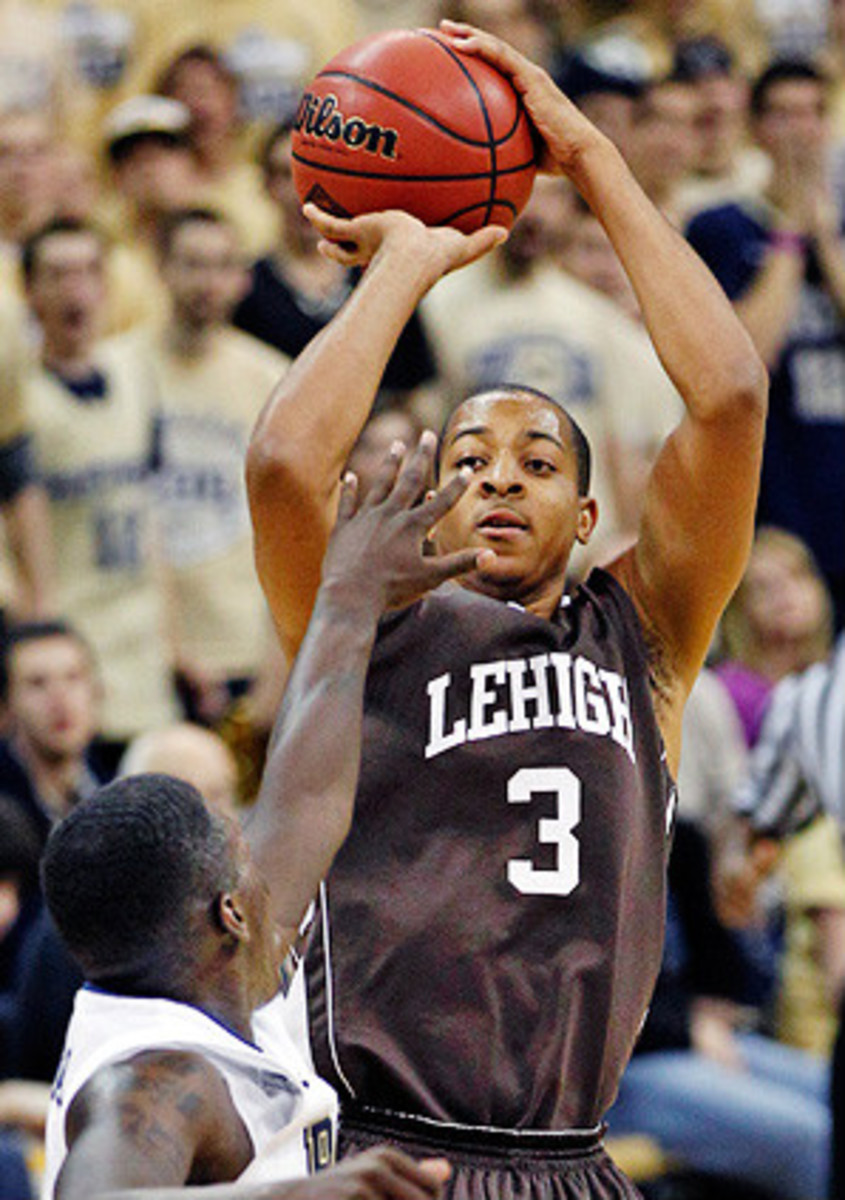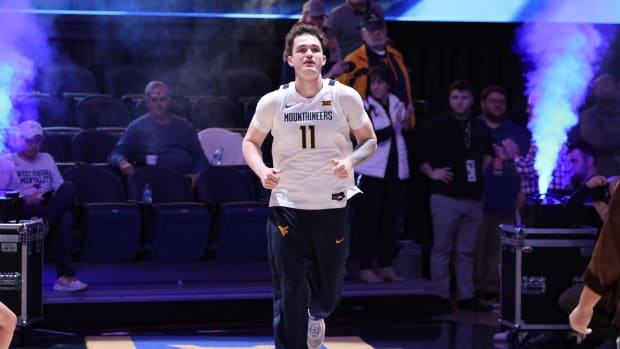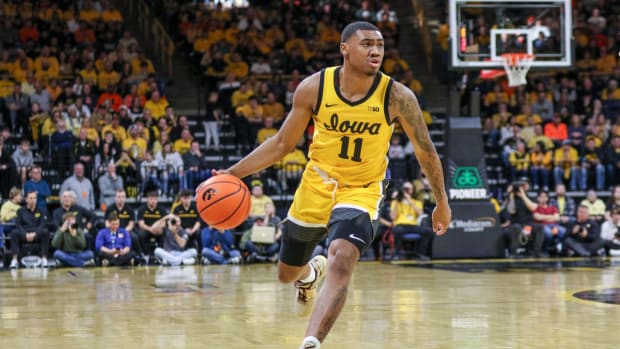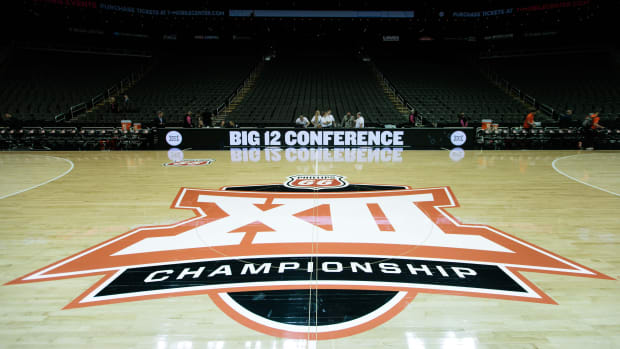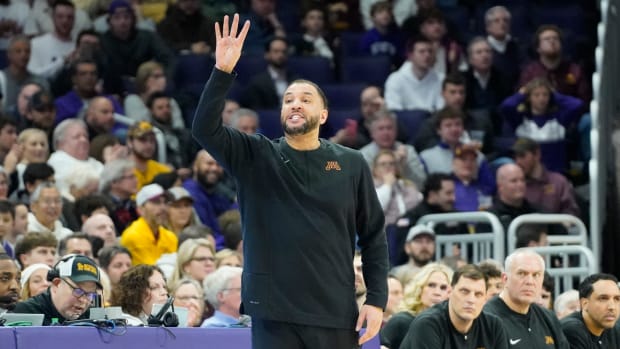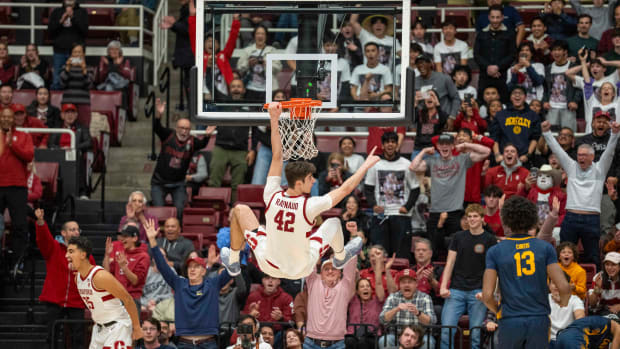Time for change in the NCAA, weekend picks, more Hoop Thoughts
Well of course, you say. They're presidents, after all. That's what they do: Preside over things. Hasn't this always been the case?\n
Actually, it hasn't. The idea of assigning this enterprise to university presidents -- the vast majority of whom have never played, coached or administered a college sport -- is a relatively recent idea. The NCAA was founded in 1906, and for the first nine decades of its existence, it was run primarily by people who came out of the sports world. That began to change in 1984 when, in response to what was viewed as widespread greed, corruption and rulebreaking, the NCAA created a Presidents Commission so that the people who led its universities could get more directly involved in the scourge of athletics.
Five years later, the NCAA convened a blue-ribbon panel of academics and asked it to come up with some recommendations. The Knight Commission, as it came to be called, issued three reports between 1991-93. The first was the most groundbreaking, a paper that was titled "Keeping Faith with the Student-Athlete: A New Model for Intercollegiate Athletics." Citing the rash of schools that were penalized during the 1980's, the Commission argued in its report that "at their worst, big-time college athletics appear to have lost their bearings ...The Commission's bedrock conviction is that university presidents are the key to successful reform. They must be in charge -- and be understood to be in charge -- on campuses, in conferences and in the decision-making councils of the NCAA."
The Knight Commission suggested that the NCAA adopt a "one-plus-three" model that established presidential control (the "one") over three key areas: academic integrity, financial integrity, and independent certification. Three years after the commission completed its work, the NCAA implemented a new governance structure that had at its apex an Executive Committee of 16 presidents lording over the entire NCAA. Division I schools were placed under the authority of a Board of Directors made up of 18 presidents.
Thus, instead of just standing back and managing large-scale initiatives, presidents for the first time were placed deep into the weeds of regulating college sports. It sounded like a wonderful idea. A New York Times editorial praised the NCAA for having "lifted chapter and verse" the Knight Commission's recommendations.
Now, let's ponder what presidential leadership has brought us these last 16 years. Have fewer schools been punished for cheating? Have costs been brought under control? Have we experienced a growth in academic integrity? Less chasing of the almighty dollar?
The answers are painfully obvious. At the very least, the presidents haven't done any better a job of running college sports than the athletics professionals and NCAA lifers who preceded them. More probably, they have made things worse -- in some respects, much worse.
For example, the Knight Commission complained in 1991 that "the best coaches receive an income many times that of most full professors." So where have coaches' salaries gone since the presidents took over? Way, way up.
The Commission also bemoaned the fact that in "the search for television revenues, traditional rivalries have been tossed aside in conference realignments." We know all too well what has happened on that front. In 2003, the university presidents from the ACC demonstrated quite clearly how much they valued revenues when they reached into the Big East and poached Miami and Virginia Tech. They pilfered Boston College a year later. "Welcome to the world of presidential control," cracked Mike Tranghese, who was then the Big East commissioner. Shortly thereafter, the presidents from Tranghese's own league surrendered what was left of their moral authority by raiding Conference USA to replace the departed schools.
Fresh Takes: Seth Davis breaks down the hottest topics in college basketball
Those moves accelerated the downward spiral that culminated last weekend with the demise of the Big East as we knew it. The realignment feeding frenzy of the last three years has literally devoured the heart and soul of college athletics. And make no mistake, it's presidents who are engineering these moves. Public documents acquired by the Connecticut Post in January revealed that as Syracuse and Pittsburgh were getting ready to bolt the Big East, UConn president Susan Herbst wrote an email to a colleague that read in part, "In general, at this point at least, ADs are not running the discussion around the country and a lot is happening." That's right: As the landscape of athletics was being irretrievably altered, the people who know the most about athletics were not even in "the discussion."
We've also learned these past 16 years that presidents can be just as feckless, hypocritical and corrupt as coaches and athletic directors (and doctors and lawyers and bankers and sportswriters). Yet, their holier-than-thou attitude persists. The year 2003 was a particularly bad one for presidential integrity. The president at St. Bonaventure, Robert Wickenheiser, resigned after it was revealed that he personally intervened to admit a junior college basketball transfer who should have been ineligible. Auburn president William F. Walker embarrassed his institution when he rode on a private plane full of boosters in an effort to hire a football coach -- even though his school already had one. The presidents at Missouri, Georgia and Fresno State also had direct hands in scandals that tarnished their basketball programs. Two of those presidents (at Georgia and Missouri) had served on the Knight Commission.
And yet, one of the sessions at the NCAA convention the following January was titled "The President's Role in Maintaining the Integrity of Intercollegiate Athletics on Campus." I kid you not.
Fast forward to the summer of 2011 when, during a retreat of NCAA presidents, the group received a stern lecture from one of their own. "A lot of these things have reached a boiling point," said the speaker, who had served as the chair of Division I's board of directors and sat on the committee of six presidents that ran the Bowl Championship Series. "There's a unanimity of thinking of a very large number of presidents saying, 'We've reached a point where we must pay more attention to these academic issues, to these integrity issues.' "
The man who uttered those words? Penn State president Graham Spanier. That would be hilarious if it weren't so sad.
All of this prompted one of the founding members of the Knight Commission to admit recently that their ideas haven't worked. Writing in The Chronicle of Higher Education in December 2011, Dr. William C. Friday, the president emeritus of the University of North Carolina system who died in October, conceded that despite the reforms implemented based on his commission's recommendations, "big-time college sports today bears only a slight resemblance to the goals and objectives for which intercollegiate athletics were begun in America. ... It is time for those directly responsible to exert strong leadership and bring an immediate end to the shameful exploitation and abuse."
Agreed. But sometimes, strong leadership requires admitting you're in over your head. So let me issue my own recommendation to the presidents now running the NCAA. Your hearts may have been in the right place, but there is no denying what happened: You took over college sports, and you screwed it up. Now do the right thing and give it back.
Other Hoop Thoughts
? You'd be hard pressed to find a player who is helping his team in more areas -- including leadership -- than Arizona's Solomon Hill.
? I like Deshaun Thomas, but I don't like that he needed 21 shots to score 21 points in what should have been an easy home win for Ohio State over Winthrop on Tuesday night.
? Not too many coaches of top-ranked programs play any kind of nonconference road game unless it's a TV-mandated event like the Big Ten/ACC challenge. It's almost unheard of for them to play true road games against mid-major schools because there is no upside. If you win, you're supposed to; if you lose, you're embarrassed. So when I see Michigan playing at Bradley and Michigan State playing at Bowling Green, I am not only grateful, I am also impressed. And I believe those kinds of games are the best preparation for the conference season.
? Good to see freshman point guard Kris Dunn in the lineup for Providence this week. Dunn suffered a torn labrum in his shoulder, and all he did in his collegiate debut was dish out 13 assists. Catch him if you can. Dude can ball.
? Duke redshirt freshman Marshall Plumlee was supposed to make his debut Wednesday night against Cornell, but the 6-foot-11 freshman center was limited to two minutes because he was uncomfortable with the orthotic designed to protect his left foot. We'll see if he gets more run Thursday night against Elon, but I know Duke is hoping that he can give the team some needed frontcourt depth moving forward.
? Pretty amazing (and not in a good way) to see Baylor's Brady Heslip three-point shooting drop from 45.5 percent last season to 34.9 percent this season. If you take away his 8-for-13 performance from behind the arc in the win over St. John's, Heslip is only converting 28 percent.
? Bummer to see Wichita State get hit by a rash of injuries just when it cracked the rankings. The latest victim was 6-3 redshirt freshman Ron Baker, who suffered a stress fracture in his left foot that will keep him out six weeks. Three Shockers starters are currently out of action, including 6-8 senior forward Carl Hall, the team's leading scorer and rebounder who had surgery on Tuesday to repair a broken thumb. Hall will be out four weeks.
? One of the reasons I think Murray State is better than last season despite having already lost a game is the improvement of 6-3 senior guard Stacy Wilson. While playing behind Donte Poole a year ago, Wilson averaged just 4.3 points in 10.6 minutes. With Poole having graduated, Wilson is averaging 16.1 points in 29.3 minutes. This is the Next Man Up culture that defines the special mid-major programs like Gonzaga, Xavier, VCU and Butler.
? Richard Howell may not be N.C. State's most talented player, but he is its most valuable.
? Saw a story recently describing how Michigan point guard Trey Burke feels a lot fresher after games because of the strength work he put in during the off-season. That's a great example of why players typically make the biggest improvement between their freshman and sophomore years of college than at any point in their careers.
? Next time you're listening to a color analyst call a game, ask yourself: Is he just reacting to what he sees, or did he prepare? The ones who prepare are the ones worth listening to.
? Love that Illinois coach John Groce wore an orange blazer on Sunday because the Illini's former coach, Lou Henson, who was famous for wearing that kind of jacket, was at the game.
? Two thoughts on Miami's senior forwards: If Kenny Kadji could score in the post with his basket to the basket, he would get 20 a game. And if Reggie Johnson could drop 30 pounds, he'd be a lottery pick.
? Is it time to contemplate an NCAA tournament without North Carolina? Me thinks so.
? People bemoan the increase of transfers, but Garrick Sherman's transfer to Notre Dame is a great example of how everyone can benefit. It would have been hard for Sherman to get major minutes if he had stayed at Michigan State, and his discontent could have been a potential distraction. Now, Sherman is off the books at Michigan State and he's an important contributor for the Irish, averaging 10 points and 4.4 rebounds in 18.4 minutes. He's playing ball, having fun, and working toward his degree. Hard to see the downside.
? Really hoping Indiana's Maurice Creek was right when he tweeted that he would return this season, but it's disquieting to see him get hurt again. The 6-5 junior guard from Maryland has already come back from two knee fractures and a torn Achilles. He injured his right foot in practice on Sunday, and the school said he would be out indefinitely.
? Florida State has had more than its share of injuries, but when Leonard Hamilton sat his best player and senior leader, Michael Snaer, for the entire game against Louisiana-Monroe because of a "discipline issue," that's a red flag.
? Don't look now but Georgia Tech is 7-2. We'll find out whether the Yellow Jackets are any good pretty soon. Look at their schedule in early January: Miami, at N.C. State, Virginia Tech, at Duke and at North Carolina.
? As long as I'm in the ACC, allow me to give my annual reminder that Wake Forest, which is currently 5-5 and headed for another basement finish in the league, fired Dino Gaudio in 2010 after he took the Demon Deacons to the second round of the NCAA tournament. Worst firing of the last 10 years IMHO.
? I'm still waiting for Luke Hancock to have his breakout game for Louisville. In the preseason, Rick Pitino said the transfer from George Mason was the key to the Cardinals' season, but so far he is shooting a woeful 33 percent from the floor and 29 percent from three-point range. Hancock is clearly not comfortable yet in his new surroundings.
? I think there are too many technical fouls called against players for hanging on the rim. I'd like this rule to be tweaked so the guys have more latitude to protect themselves. Unless it's a really egregious act of showmanship, we should err on the side of safety.
? I'm really impressed that Missouri forward Laurence Bowers returned from his ACL injury a vastly improved outside shooter. You can't do a lot basketball-wise when you have that kind of injury, but one thing you can do is shoot. That shows me the kid has a terrific work ethic, and it's paying off.
? When a player is described as not being vocal but rather a "leader by example," I'm not buying it. I don't think you can be a good leader without using your voice. To me, "leading by example" means not leading.
? Gonzaga freshman center Przemek Karnowski is shooting 38.9 percent (14-for-36) from the foul line. Who does he think he's playing for, the Lakers?
? It's amazing the way Winthrop coach Pat Kelsey's comments about Newtown went viral. The man knew he had a unique opportunity and he took advantage of it. Regardless of how you feel about what he said, I'm grateful when someone in his position uses that kind of forum to advance social progress. I only wish more people in and out of sports did that.
Making A List ... Checking It Twice
Five guys I would want to take the last shot:
C.J. McCollum, 6-3 senior, Lehigh. How many people realize that McCollum is having an All-America-caliber season? Not only is he leading the nation in scoring at 24.9 points per game, but he's ranked fifth in three-point percentage at 51.9. There's no better guard in America at creating his own shot.
Rotnei Clarke, 6-foot senior, Butler. He's a shooter and a scorer, and he's got the clutch gene. Just ask Marquette.
Isaiah Canaan, 6-1 senior, Murray State. Another great pure shooter (47.1 percent from the floor, 42.9 percent from three) who is also dishing out nearly four assists per game. So if he doesn't drill the game-winner, he'll get the ball to someone who will.
Brandon Paul, 6-4 senior, Illinois. He's making nearly 40 percent from three and can dominate a game with his scoring like few other players in the country. Best of all, he loves the big moment.
Cashmere Wright, 6-foot senior, Cincinnati. He's currently ranked 14th in the country in three-point shooting (47.5 percent), which is highly unusual for a point guard. He has already hit the season's second-most dramatic buzzer beater (next to Clarke's heave vs. Marquette), a baseline fadeaway over a seven-footer to beat Alabama.\n
Weekend Pickoff
Syracuse vs. Temple at Madison Square Garden, Saturday, Noon, ESPN2
The Owls are ranked 10th in the Atlantic 10 in three-point shooting, and despite playing a mediocre schedule they have fewer rebounds than their opponents this season. They were pummeled on the boards (36-28) in a home loss to Canisius Wednesday. Not a great combo to go up against the toughest zone D in the country. Syracuse 75, Temple 61
Kansas at Ohio State, Saturday, 4 p.m., CBS
The Jayhawks have improved in all the right ways since they lost to Michigan State in Atlanta. I think they're ready to bust out. Kansas 75, Ohio State 70
Illinois vs. Missouri at St. Louis, Saturday, 6 p.m., ESPN2
Illinois' three-happy scheme scares me, but in a big game against a rival, I think the Illini will be focused and ready to splash. Missouri has some nice new pieces, but the Tigers haven't jelled yet. Illinois 78, Missouri 74
Texas at Michigan State, Saturday, 2 p.m., ESPN2
I don't know if Gary Harris will stay all four years at Michigan State, but if he does, I think he could be in the Magic-Mateen-Draymond class of leadership. This kid is special, inside and out. Michigan State 69, Texas 52
Murray State at Dayton, Saturday, Noon, CBS Sports Network
The Racers are ready to prove my theory right that they're better than they were last season, but this one will be no flyover. Dayton may have suffered a tough one-point loss to a good Illinois State team on Wednesday night, but the Flyers beat Alabama on the road and have a terrific guard in 6-foot senior Kevin Dillard (15 points and 4.1 assists per game). Murray State 80, Dayton 76
Florida vs. Kansas State in Kansas City, Saturday, 8 p.m., ESPN2
The Gators need to bounce back from their pratfall in Tucson, although it won't be easy in this quasi-road environment. Scott Wilbekin is playing despite a broken finger, and that is a lingering concern. Florida 72, Kansas State 67
Stanford at Northwestern, Friday, 9 p.m., Big Ten Network
Stanford is in the midst of a tough little road swing after losing at N.C. State on Tuesday night. If the Cardinal can't upend a Northwestern team that just lost its second-leading scorer, Drew Crawford, to a season-ending shoulder injury, then it will really be panic time in Palo Alto. Stanford 62, Northwestern 54
South Dakota State at New Mexico, Saturday, 2:30 p.m.
The Nate Wolters angle will be fun, but this will be the third of a six-game road trip for the Jackrabbits. New Mexico's Tony Snell isn't hunting his shot and scoring the way he did in November, but I think the Lobos are a better team for it. New Mexico 73, South Dakota State 61
LSU at Marquette, Saturday, 2 p.m., ESPNU
LSU is quietly off to a surprising 7-1 start, but its record is inflated by a weak schedule. When the Tigers played a road game against a decent opponent, they got throttled by 19 points at Boise State. Marquette 75, LSU 63
Florida State at Charlotte, Saturday, 2 p.m., CBS Sports Network
Charlotte's 11-1 record is also not nearly as good as it looks. The 49ers-0">49ers' best win came at Davidson, and when they had a chance to play a real game, they lost at Miami by 31 points. Florida State 70, Charlotte 64
Last week: 5-5
Season record: 32-18
E-mail Bag
Regarding Cal's 'Cats, if they should enter conference play with four losses (assuming a loss to Louisville), what would it take for them to re-enter the Top 25? Given that scenario and the low luster for the SEC, what is the path to redemption? (Recognizing that beating the Cardinals would help.) My guess is that an Izzo, K, Boeheim, Self would not have been similarly treated so early in the season.-- Tom, Cape Cod
First of all, with all due respect you can spare me the conspiracy theories. Voters care about wins and losses, not coaches. If you don't believe me, ask Roy Williams.
Kentucky does seem to be playing better of late, but that could obviously be a reflection of their weak competition (Samford, Portland and Lipscomb). Ryan Harrow started at point guard on Wednesday night and is beginning to assert himself a little bit as a leader. Even though it will be hard to notch marquee wins in a weakened SEC, if the Wildcats want to get back in the rankings, then they need to avoid bad losses. The biggest challenge is the schedule, which has Kentucky playing six out of nine games on the road beginning in mid-January. Yes, that means Kentucky has some back-loaded home games, but a young team with tissue-thin confidence needs to get its quality wins earlier than later. So right now, Kentucky has much bigger problems than simply getting back into the Top 25.
As a Syracuse fan, I urge you to take a closer look at the foul shooting and three-point shooting stats. They are not as bad as you would think. The poor foul shooting is mainly from their three center/forwards Coleman, Christmas and Keita. I don't think any of them will be handling the ball in the last couple of minutes of a game. As for three-point shooting, their main shooters, Southerland, Cooney and Triche are fine. Historically SU is not a great foul shooting team, but it is good enough to win.--Peter Greene, Los Angeles
I sense Peter is indulging in a little hopeful rationalization here (as is every fan's right). I agree that foul shooting is not a huge concern because most of the starters, including Rakeem Christmas (75 percent) shoot a pretty good clip. But I honestly believe the three-point shooting could come back to haunt this team. The two primary ballhandlers, Brandon Triche and Michael Carter-Williams, are making a combined 21-for-75 on the season (28 percent). That second number is the critical one, because it shows that even though they are not making a good percentage, Triche and Carter-Williams still feel compelled to take a lot of threes. Until they start making them, teams will be content to let them keep jacking.
Keep in mind that Syracuse is a legitimate national championship contender, so much of this is the nitpicking we always do when we scrutinize the nation's best teams. When I talk about how the three-point shooting will affect the Orange, I'm thinking how it will matter in a regional final or Final Four game. Inevitably, every team faces adversity in the NCAA tournament. Could be foul trouble, could be an off shooting night, could be a bad matchup. The ability to make threes gives a team breathing room in a close game, and it can erase a lot of other things that are going wrong. Outside of James Southerland, Syracuse simply does not have a player that opponents fear from behind the arc. I'm not saying they can't win a national championship that way. I'm just saying it's a little harder.
I was wondering if you think Duke freshman Rasheed Sulaimon is a candidate to be a glue guy this year. He scores buckets, makes assists, is the only guy on Duke who can efficiently drive in the lane, and seems to always make "winning" plays for the most proven team in college basketball. I think without him, Duke would be significantly different and may not be undefeated.-- John Park, Durham, N.C.
I certainly agree that Duke would be worse off without Sulaimon. One thing that has gone unremarked upon is the fact that Duke is playing this season without senior guard Andre Dawkins, who took the year off to deal with personal issues. If Dawkins had been on the team, that would have put pressure on Coach K to start him. Dawkins is a very good outside shooter, but he was inconsistent and was a lousy defender, which is one of the reasons why Duke lost to Lehigh in the NCAA tournament. Sulaimon, on the other hand, is a tough, clutch, mature player whom Krzyzewski has compared to Nolan Smith as a junior. He is clearly one of the top five or six freshmen in the country.
However, if I were to pick out a glue guy on this team, it would be 6-1 junior guard Tyler Thornton. He better fits what I consider the glue guy's profile. Thornton is an older player who is willing to come off the bench, play hard-nosed defense and fill a variety of roles. He is also this team's strongest and most vocal leader.
Thornton also fills a very important job between games -- namely, as a fill-in for Seth Curry, who is unable to practice most of the time because of chronic pain in his lower leg. Glue guys by definition are unsung, so I'm grateful for the chance to sing Thornton's praises.
